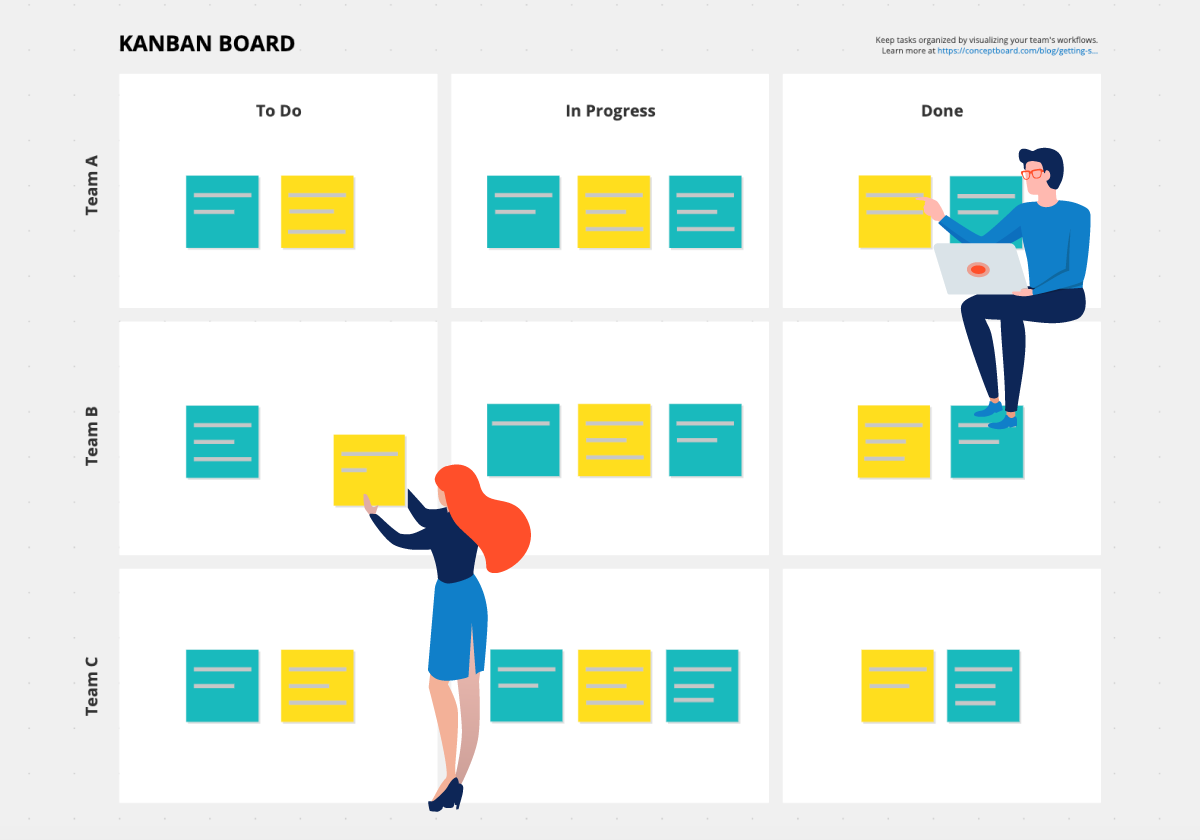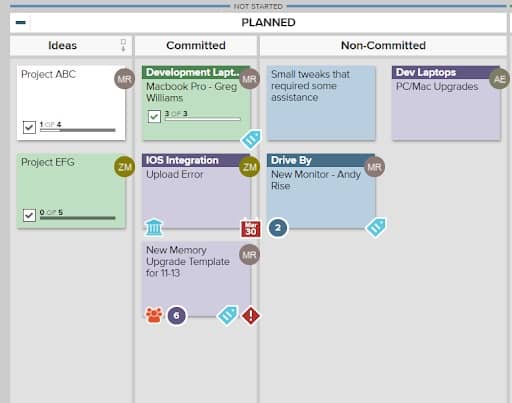Kanban boards are effective tools for project tracking. They offer a visual way to manage tasks.
Managing projects can be complex. You need to keep track of tasks, deadlines, and team progress. Kanban boards help simplify this. They provide a clear visual of what needs to be done, what is in progress, and what has been completed.
This method boosts team efficiency and ensures everyone is on the same page. By using Kanban boards, you can easily spot bottlenecks and manage workflow better. This approach not only enhances productivity but also improves communication within the team. Dive into the many benefits of Kanban boards and see how they can transform your project tracking.
Introduction To Kanban Boards
Kanban boards are visual tools for tracking and managing tasks. They help teams see progress. Teams can quickly identify bottlenecks. This makes it easier to improve workflows.
Kanban boards use columns and cards. Each column represents a stage in the process. Cards represent tasks. Moving a card from one column to another shows progress. It’s a simple yet powerful method.
What Are Kanban Boards?
Kanban boards are organizational tools. They show tasks and their status. This visual system helps teams stay on track. It ensures tasks move smoothly through each stage.
Teams can see all tasks at a glance. This transparency helps everyone understand their responsibilities. It also fosters collaboration. Everyone knows what needs to be done.
History And Evolution
Kanban originated in Japan. Toyota introduced it in the 1940s. They used it to improve manufacturing processes. The goal was to reduce waste and increase efficiency.
Over time, other industries adopted Kanban. It is now popular in software development. Many teams use it for project management. The principles remain the same. Visualizing work and limiting tasks in progress are key.
Kanban has evolved with technology. Digital Kanban boards are now common. They offer more features and flexibility. Teams can access them from anywhere. This makes them ideal for remote work.
Discover engaging insights on Project Management by reading this featured article. Top Project Management Tools for Remote Teams: Maximize Efficiency
Visualizing Workflows
Kanban boards are an excellent tool for visualizing workflows. They allow teams to see their work in progress and manage tasks effectively. A visual representation of tasks helps teams stay organized and productive.
One can quickly understand what needs to be done, what is in progress, and what has been completed. This clear visibility helps in better project tracking and management.
Tracking Progress
Kanban boards make tracking progress straightforward. Each task is represented by a card that moves across columns. These columns typically include stages like “To Do,” “In Progress,” and “Done.”
This layout helps everyone see the status of each task at a glance. It also helps in identifying which tasks need attention and which are moving smoothly.
Teams can easily update the status of tasks by moving cards from one column to the next. This simple action keeps everyone informed and aligned.
Identifying Bottlenecks
One of the significant benefits of Kanban boards is identifying bottlenecks. When tasks pile up in one column, it signals a problem area.
This visual cue helps teams to address issues before they become bigger problems. It ensures that work flows smoothly through each stage of the project.
By regularly reviewing the board, teams can spot and resolve bottlenecks quickly. This proactive approach improves efficiency and productivity.
| Column | Description |
|---|---|
| To Do | Tasks that need to be started |
| In Progress | Tasks currently being worked on |
| Done | Completed tasks |
Using these columns helps teams stay on track and organized. It provides a clear picture of the project’s status at any point in time.
Enhancing Efficiency
Kanban boards are powerful tools that help teams track projects. They enhance efficiency by visualizing tasks and workflows. This leads to clearer priorities and better collaboration.
Reducing Waste
Using a Kanban board reduces waste in several ways:
- Fewer Bottlenecks: Teams can see where work is stuck and address it quickly.
- Less Overproduction: Only tasks that are needed now are worked on.
- Minimized Motion: Team members know exactly what to work on next.
By reducing waste, teams can focus on tasks that add value.
Want to know more about Project Management? Check out this article for helpful insights. How to Choose the Best Project Management Software: Expert Tips
Improving Time Management
Kanban boards help improve time management:
- Clear Prioritization: Tasks are organized by priority, so important work gets done first.
- Better Scheduling: Teams can plan their work and meet deadlines more reliably.
- Increased Visibility: Everyone knows who is working on what, reducing confusion.
These benefits lead to a more efficient and productive team.

Credit: getnave.com
Promoting Collaboration
Kanban boards are essential for project tracking. They make team collaboration easier. By using visual cues, team members stay on the same page. Everyone sees what needs to be done. This shared visibility enhances teamwork and efficiency.
Team Communication
Effective communication is key to project success. Kanban boards facilitate this by providing a clear visual representation of tasks. Team members can quickly see who is working on what. This reduces the need for frequent meetings and status updates.
Kanban boards often include comment sections. Team members can leave notes and updates here. This feature ensures that everyone is informed of any changes or issues. Communication becomes more streamlined and less prone to misunderstandings.
Shared Responsibilities
Kanban boards promote shared responsibilities. They help distribute tasks evenly among team members. Everyone knows their roles and responsibilities. This clarity reduces confusion and increases accountability.
Teams can use Kanban boards to track progress and identify bottlenecks. If one member is overloaded, others can step in to help. This ensures that no one is left behind and deadlines are met.
| Benefit | Description |
|---|---|
| Clear Task Assignment | Each task is assigned to a specific team member, reducing confusion. |
| Progress Tracking | Team members can see task progress in real-time. |
| Issue Identification | Identify and address issues quickly through visual cues. |
In summary, Kanban boards are powerful tools for promoting collaboration. They improve communication and distribute responsibilities. This leads to more efficient project tracking and successful outcomes.
Flexibility And Adaptability
Kanban boards offer unmatched flexibility and adaptability for project tracking. They allow teams to adjust their workflows and scale their processes effortlessly. This makes managing projects easier and more efficient.
Want to know more about Project Management? Check out this article for helpful insights. Free Project Management Software for Startups: Boost Productivity Today
Adjusting Workflows
With Kanban boards, you can modify workflows as your project evolves. You can easily add or remove tasks, change priorities, and update deadlines. This ensures that your team stays on track and adapts to changes swiftly.
Here are a few ways to adjust workflows:
- Adding new tasks: Introduce new tasks as they come up.
- Removing completed tasks: Clear out tasks that are finished to keep the board clean.
- Changing task priorities: Move tasks around to reflect their current importance.
- Updating deadlines: Adjust deadlines to keep the timeline realistic.
Scaling For Teams
Kanban boards are ideal for scaling. They can accommodate teams of any size, from small groups to large departments. This ensures that everyone stays aligned and informed.
Consider these advantages of scaling with Kanban boards:
- Visibility: Everyone can see the tasks and their statuses.
- Collaboration: Team members can easily collaborate and share updates.
- Accountability: Each task has an owner, making it clear who is responsible.
- Real-time updates: Changes are instantly visible to the entire team.
In summary, Kanban boards offer great flexibility and adaptability. They make adjusting workflows simple and scaling for teams easy. This makes them a powerful tool for project tracking.
Boosting Productivity
Kanban boards can significantly enhance productivity in project tracking. They provide a visual representation of tasks. This helps team members understand their responsibilities. It also ensures that everyone is on the same page.
Kanban boards help teams set clear goals and measure performance. This structured approach leads to more efficient workflows. Team members can focus on their tasks without confusion. This results in faster project completion.
Setting Clear Goals
Clear goals are essential for any project. Kanban boards help teams define these goals. Each task is represented by a card. These cards are then placed in columns. The columns represent different stages of the project.
Team members can see what needs to be done. They can also see what has been completed. This visual clarity helps avoid misunderstandings. It ensures that everyone knows what to focus on.
Measuring Performance
Performance measurement is crucial for any project. Kanban boards make this easy. By tracking task progress, teams can identify bottlenecks. They can also see which tasks are taking longer than expected.
This information helps teams improve their processes. It allows them to allocate resources more effectively. Over time, this leads to better performance and higher productivity.
In summary, Kanban boards offer a simple but effective way to boost productivity. They help teams set clear goals and measure performance. This structured approach leads to faster and more efficient project completion.
Implementing Kanban Boards
Implementing Kanban Boards is a strategic step for improving project tracking. These boards provide a visual representation of tasks. They allow teams to see the progress and status of each task easily. To get the most out of Kanban Boards, it is essential to choose the right tools and follow best practices.
Choosing Tools
Picking the right Kanban Board tools is crucial. There are many options available, both free and paid. Some popular choices include:
- Trello: User-friendly interface, suitable for small to medium teams.
- Jira: Great for larger teams, offers advanced features.
- Asana: Integrates well with other tools, good for comprehensive project management.
When choosing a tool, consider the size of your team, the complexity of your projects, and your budget. Look for tools that offer customization options. Ensure they integrate well with other systems you use.
Best Practices
To make the most of Kanban Boards, follow these best practices:
- Define Clear Columns: Set up columns like “To Do,” “In Progress,” and “Done.”
- Limit Work in Progress: Avoid taking on too many tasks at once. This helps maintain focus.
- Regular Updates: Keep the board updated. Ensure tasks reflect their current status.
- Use Cards Effectively: Include details, deadlines, and assignees on each card.
- Team Collaboration: Encourage team members to update the board regularly.
These best practices ensure your Kanban Board remains an effective tool for tracking projects. They help keep the team organized and projects on track.

Credit: conceptboard.com
Real-world Applications
Kanban boards have become an essential tool in project tracking across various industries. These boards provide a visual representation of work processes, enhancing clarity and efficiency. Let’s explore some real-world applications of Kanban boards.
Industry Examples
Kanban boards are widely used in the software development industry. Teams can visualize tasks, track progress, and identify bottlenecks. This leads to improved workflow and timely delivery.
In manufacturing, Kanban boards help manage production processes. They streamline the movement of materials and ensure that each production stage is on schedule.
Healthcare professionals use Kanban boards to organize patient care. They track treatment plans, medication schedules, and staff assignments. This improves patient outcomes and reduces errors.
Success Stories
A small tech startup adopted Kanban boards for project management. Within months, the team saw a 40% increase in productivity. Tasks were completed on time, and employee morale improved.
A large manufacturing company implemented Kanban boards to manage inventory. This resulted in a 25% reduction in waste and significantly lowered costs.
A hospital used Kanban boards in their emergency department. Patient wait times decreased by 30%. Staff coordination improved, leading to better patient care.

Credit: www.planview.com
Frequently Asked Questions
What Are Kanban Boards?
Kanban boards are visual tools used in project management. They help teams track tasks and workflows. They enhance productivity and collaboration.
How Do Kanban Boards Improve Productivity?
Kanban boards improve productivity by visualizing tasks. They make it easy to identify bottlenecks and manage workload. This leads to better task prioritization.
Can Kanban Boards Be Used For Remote Teams?
Yes, Kanban boards are ideal for remote teams. Online Kanban tools enable real-time collaboration. They keep everyone updated regardless of location.
Are Kanban Boards Suitable For All Project Types?
Kanban boards are versatile and can be used in various projects. They are effective in software development, marketing, and manufacturing. They adapt to different workflows.
Conclusion
Kanban boards offer clear benefits for project tracking. They improve task visibility and streamline workflows. Teams stay organized and focused on priorities. Efficiency increases as bottlenecks get identified quickly. Collaboration becomes easier with transparent task management. Kanban boards adapt to various projects and team sizes.
They ensure better project outcomes and timely deliveries. Implementing Kanban is a step towards smoother, more effective project management. Experience the simplicity and productivity boost today.










